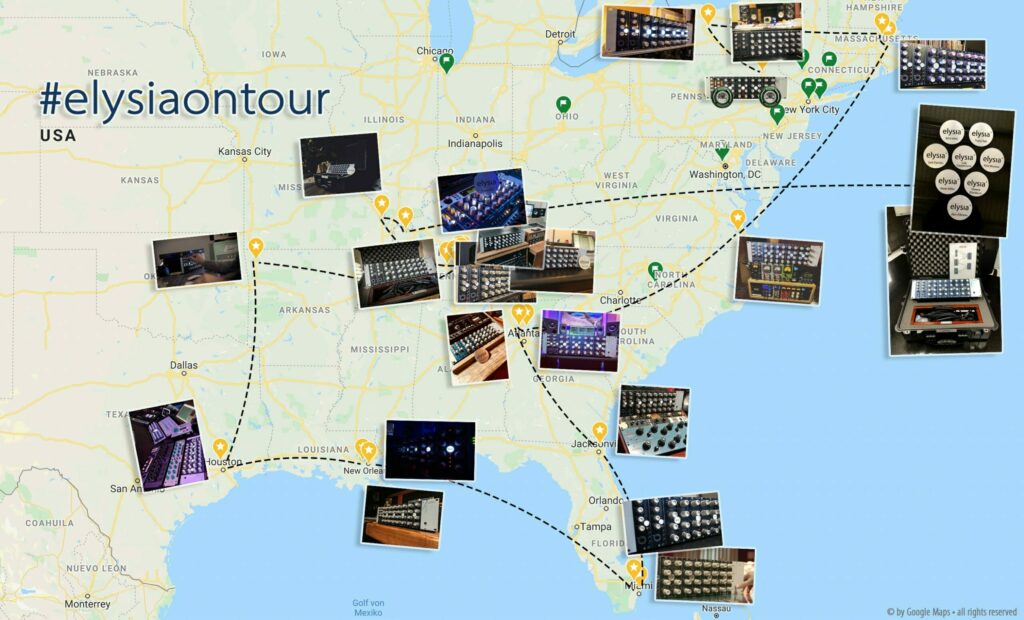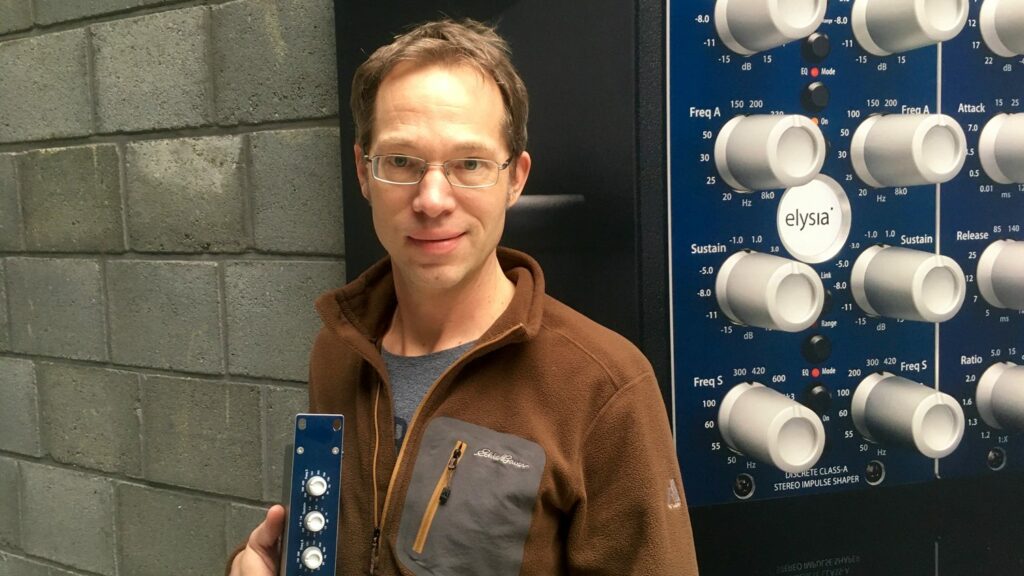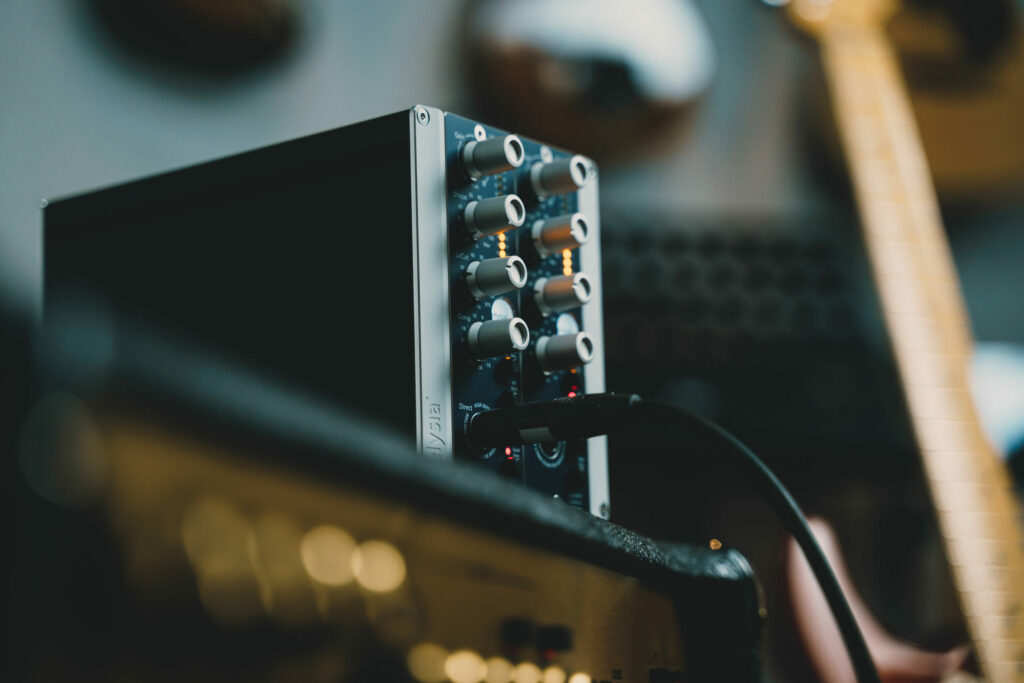Transient Designer Story Part 2/2
In the previous Episode of my Transient Designer Story, I wrote about the ups and downs and how i came to the idea to develop the Transient Designer Technology. Gave you some insights on my work. Also i wrote about the development of my first Compressor – The DynaMaxx. If you haven’t read the first Part yet, please click here.
(translated from the original german article)
Flash of inspiration: difference – the crucial idea
I’m not exactly sure when, where and how I picked up the topic “difference”. But I think I remember reading about a trick in an issue of the Keyboards Magazine to use some kind of exciter for samples with the EPS 16+ sampler. One sunny day I got the ultimate inspiration flash. The next day I had another lucky circumstance. My boss, Hermann Gier, with whom I was sitting in the same office, was going on a business trip for two days. Now I was finally able to build my new idea on a real lab board.



I then applied this difference theory to the envelopes of my compressor. And instead of just one circuit I had two in parallel. These had different time constants. I chose different attack times but the same release time. I added a differential amplifier – and all of a sudden the scales fell from my eyes and ears: Because I could suddenly see the transients of the signal! With very soft transients both envelopes were equal and hardly formed a difference, with fast signals this could be recognized and put into a VCA.
The brilliant aspect of this was that no threshold was necessary since the difference worked independently of the input level. Next! Another genius idea popped into my mind. The control voltage could now be positive or negative, which meant that the VCA would amplify or attenuate. The transients could now be amplified as well as attenuated! I thought that was genius.
I finished my new circuit in a single day. Afterward, I asked myself, what if these envelopes had the same attack but different release times?
So the next day – new luck. I built up exactly this part of the circuit the next day and it worked at first attempt. So now I could control the sustain! I was out of my mind because I could achieve an amazing effect with just two knobs. I couldn’t get the grin off my face.
Day three – Return of the Boss. On the third day, Hermann came back from his business trip and I presented him my new invention. He was immediately enthusiastic and wanted me to implement the product quickly. But…
Codeword.Yellow Kick Man!
Endless days in the dark with the envelopes – the fine-tuning
So, my boss liked my invention and now wanted the product to be finished as soon as possible. After the first euphoria, I was disillusioned during a simple test with a drum loop. When I started it, the first beat was the loop, mostly the bass drum was very loud, but the further beats were quieter.
Looking for the reason I found it very quickly. At the beginning of the loop, the difference was simply much bigger than with the following ones. I had a simple analog oscilloscope at hand with which I now tried to observe the generated envelopes.
To achieve exactly this, I had to adjust the time-scale on my oscilloscope so slowly that only a low shining dot moved across the screen. Under bright sunshine, I completely darkened the room and saw that this dot glowed a little bit and I could roughly see the control voltage. It took me about three months to optimize my circuit for the different signal types. With every small change of the circuit, I repeatedly fed all sounds through the circuit to check if the respective changes had disadvantages. It was like a microsurgical operation or finding the famous needle in a haystack.
Complexity
Just to briefly explain the problem. A normal compressor usually has five controls and my circuitry is four times as complex and that is easy to explain. Because it contained several time constants and also internal thresholds, which all had to be perfectly tuned to each other. I could have given the user ten knobs per channel, but this reduction to only two knobs became the key success and stands for perfect usability. I was even able to fit four channels into one unit. And then?
The next challenge!
I wasn’t really satisfied with the overall sound, because especially with a stronger use of attack the whole signal sounded a bit too hard and very unpleasant. To solve this I put a low pass filter behind the VCA and replaced the missing highs with a coil filter again. Exactly with that, the sound became much more pleasant and softer again. To present the overall idea to a selected audience, we made some prototypes which, as usual at that time, consisted of self-etched circuit boards and were then drilled by ourselves. Ronald Prent was one of the first who worked with these prototypes. He immediately became a big fan of this new concept. Yellow Kick Man aka Transient Designer was born.

What is it? Is it a compressor or a noise gate?
The big speculation during the premiere at Prolight + Sound 1998
The Transient Designer, that’s how my finished product was officially named, was first presented to the public at the ProLight + Sound fair in Frankfurt / Germany in spring 1998 and I still remember the many questioning faces of the audience. The most asked question on our booth was: Is this a compressor? A Noise Gate? What is that?
So I gave interested fair visitors some headphones to check out the product. After a few seconds of listening, the majority of our booth visitors were amazed and enthusiastic about what was possible with this new Transient Designer. So it was a new kind of audio processor that didn’t exist before and I knew that I had created something beautiful and new. In this context, I have to say that I always find it very interesting to experience and enjoy the reactions of potential customers and it always gives me back proof that the long work on the development of a product can always be worthwhile. At premieres like this, I simply enjoy the audience’s reactions and get goosebumps. Definitely deep and emotional memories that are worth looking back on.
Thanks to the positive feedback, also from the international press, as well as the numerous positive reviews, the Transient Designer rapidly became popular and entered national and international studios in no time.
“The Transient Designer has already earned an entry in the ‘Golden Book’ of renowned studio equipment classics. The intelligent implementation of a simple idea combined with equally simple operation offers truly enormous and sometimes astounding design possibilities. (…) However, such a specific possibility to influence the transient structure of audio signals did not exist before the Transient Designer. Especially in sample-based productions, this FX dynamics processor proves to be a real elixir of life, but also in the world of production with real instruments, there are numerous possibilities of use (see ‘Listening’). So unreserved praise to the manufacturer for this development and a recommendation to you to take a closer look at this extraordinary dynamics processor…”
– Studio Magazin | Germany 1999
The simple operation with only two controllers and four channels was one of the reasons why the TD4 – Transient Designer became a successful cash cow. The four channels were, of course, predestined for editing a drum kit. Furthermore, the bang for bucks value was pretty good too.
The Envelope Conqueror V2.0 – nvelope from elysia
Next Generation Transient Shaper
In 2006 I co-founded the company elysia. Took it upon myself to develop many new and high-quality products according to my own taste and experiences.
Since I already had the necessary expertise in the development of compressors through DynaMaxx, I decided to develop another compressor. I started with the alpha compressor, it should be a mastering compressor with very special functions. Nowadays It is still our flagship and has become a modern classic in the audio world. Some years later, around 2012, I had the idea to develop a new and extended version of the Transient Designer. With all the experience I had now, especially in the design of discrete Class-A circuits, I was able to improve this idea fundamentally. Especially in finished mixes, the original circuit does not react as reliable as you would expect.
The detection of transients was not always working perfectly. Also, there are too large fluctuations in generated amplitudes. So I decided to develop the circuit again from scratch.
As a special feature, I planned filters with which you can specify the starting frequencies for the attack and a final frequency for the sustain. My basic idea was quite simple: transients always have something to do with fast and high frequencies and long release times of instruments have always something to do with lower frequencies.
Since the two filter bands can widely overlap I had to develop a special bandpass that ensures that the frequency response always remains linear. With my discrete design and my own VCAs, the sound was much punchier and clearer, which again is a real improvement. Due to this multiband concept, the editing sounds more natural now and less like a Noise Gate.
Especially shortening the sustain only in the bass range works much better now. Nevertheless, the nvelope can be operated in the so-called full-range mode, which is similar to the original Transient Designer.
If you don’t need transient processing in a mix, you can also use the EQ mode. So three possibilities in one product! Which turned out to be a real advantage.
Transient Designer – The PlugIns in the digital World
At the peak of the DAW – Mayhem, the Transmod from Sony Oxford was one of the first plug-ins that were based on my idea and exactly my circuitry. Based on the original hardware, Brainworx then developed the corresponding plug-ins for SPL and elysia, which sounds really great – but analog remains analog.
Most big DAWs now include a Transient Designer/Transient Shaper Tools. Several software manufacturers have also adopted the idea of the Transient Designer. Besides, the technology can be found as a processing tool in many drum sample players. I can only recommend everyone to test the hardware nvelope and you will see and hear by yourself that it is still the benchmark in Transient Shaping.
Closing words
In conclusion, I have to say:
Yes, the Transient Designer has become a true classic and revolutionized the audio industry both analog and digital. These are the facts of which I am of course very proud of. But also that I’m still the only one that developed the only two analog hardware versions on the market. This proofs me how complex my circuit is and it takes a lot of knowledge and experience to create something like this in the analog domain.
As this idea has spread to many plug-ins – the transient designer and transient shaper have become a standard in audio processing.
In the future, this will surely gain more importance. Thanks to the Loudness Normalization there’s even more headroom available again to let nice transients be sounded in the mixes.
So my number 1 billboard hit became a product with which I could make the audio world a bit more beautiful, better and even more creative. Even this has not brought me a Ferrari – I’m not really sad about it. What do you think? Leave a comment or your personal experience. I would be happy to discuss, exchange or philosophize with you.
I am curious.
Thank you very much for your interest.
Yours truly, Ruben Tilgner






